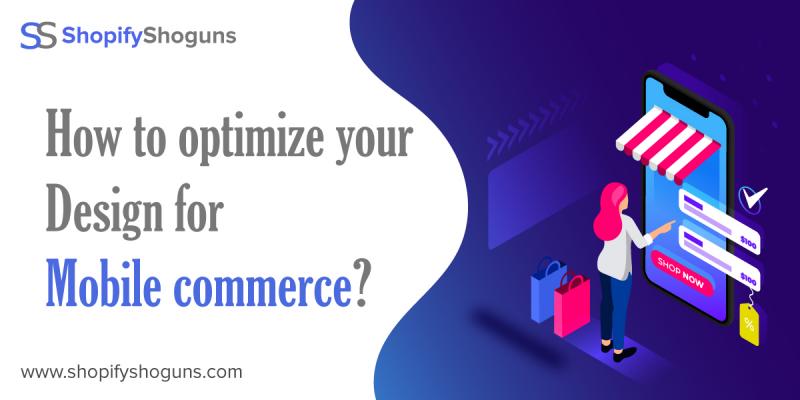How to optimize your design for 'Mobile Commerce'? - ShopifyShoguns
Reports have been harping upon the mobile commerce growth time and again, we were skeptic about that back when we were young. But boy time sure flies and according to a report by Invespcro, these stats reinforce the fact of the growth of mobile eCommerce.
1.6 billion people use mobile devices to shop online globally.
Mobile devices account for 27% of US eCommerce sales by 2018 and are only bound to grow.
53% of users shop through company-specific apps downloaded from the app store.
With these points in mind, it is all but imperative for designers to be mindful of the stores and elements they are developing. Development of a store is no longer limited to just beautifying it but even includes making it compatible for mobiles.
To further read about the best themes which help you increase the eCommerce sales to your Shopify webstore click here.
How to optimize your stores for Mobile Commerce?
The positioning of the product photography
Call to actions and product descriptions play a great role as far as the desktop applications are concerned but mobile apps are a different ball game. According to a report by emarketer shopping through mobile is expected to hit 54% by the year 2021, not having a mobile optimized site does not cut ice anymore.
Shoppers place their decisions largely on visual appeal, placing product photographs on the front and center of all your pages is what drives conversions. Take the example of Frank and Oaks mobile website, which uses a simple grid view of product display giving it a simple yet aesthetic look.
Great placement of products, minimalist design, and simple navigation is a sure shot hit to make your Shopify mobile app optimized.
Influencing shoppers with persistent “Add to cart” button
The main reason for having a mobile app is to give your customers the ease of shopping. Make your mobile application simple by having the right elements placed at the right places. Having an add to cart button on all the pages no matter where your shoppers are is the right way.
This measure ensures that buying your product is constantly on top of the customer's mind. This small design hack can help you increase your mobile sales by a considerable margin, as it makes them add your item even upon finding it slightly interesting.
An iconic brand like Apple has identified this small element and successfully implemented them on their mobile stores. They only included a small buy button instead and avoiding the unnecessary call to actions.
This buy button remains sticky no matter where the shopper on Apple store scrolls it to entice them to take a call now.
Using a fixed and minimalist navigation bar
The rise in usage of mobile has increased tactile usage, which means clicking, swiping and tapping. It has become a sensory nature of mobile shoppers too.
This behavior is like a double-edged dagger, it makes your shoppers scroll past important call to actions which are meant for them with no chance of returning. Having a minimalist sticky navigation bar is an incredible hack to make your mobile store stand out.
By integrating the sticky navigation bar into your mobile menu, you can constantly keep showcasing important elements to the shopper throughout. Tabs that matter like homepage link, check out the link and add to cart link will be constant throughout making them take an action ASAP.
Reducing user friction
The major challenge while design and developing a mobile application is taking the smaller screen and internet speeds into account.
Design and develop your mobile app in such a way that the user friction is kept to minimal. Keeping the design minimalist and focusing on functionality is the key to mobile commerce optimization. The typical touch points that need to be taken care of are.
Product searches
Payment entry
Form filling
Delivery method selection
The flow to fulfilling these elements should be taken into consideration to reduce friction and should be continuously improved based on user interaction.
Reduce unnecessary text on product pages
All said and done the mobile screens are not exactly meant for your typical shopping, so don’t clutter the screen with unnecessary text.
Have the product descriptions kept to minimal with important elements highlighted like variant option, price, quantity, material etc. If there is information which is necessary, have it hidden with collapsible menus.
Designer brand Zara does a great job in following this technique to the T. Except for a few high-quality product images with price and add to cart button the remaining information is all added under the ‘Info’ button.
This simple technique helps shoppers to be focused on the most important element that is your product.
Reduce Shopper anxiety while filling forms
Shoppers or as a matter of fact any users are apprehensive to fill up forms on websites, this insecurity increases on mobile apps. If having your user fill out their information is essential to your business, give users the ease of filling forms quickly.
Limiting the number of input fields, automatically advancing each field once it is filled, using steppers instead of dropdown menu, placing labels above the form for ease of use and clarity are some of the elements which help in reducing shopper anxiety while filling forms on your mobile apps.
Conclusion
We have close to 20 plus developers with expertise in developing customized Shopify stores as per the client requirements. From our experience of working with clients since more than a decade the standard elements which we have figured which elements exactly help businesses build a robust brand.
We have developed innumerable Shopify eCommerce stores for clients placed in both B2B and B2C domains. If you are a business or an eCommerce retailer contemplating to move onto Shopify eCommerce platform email us at info@shopifyshoguns.com or visit us at www.shopifyshoguns.com
